

The Calculator that spawned the Microprocessor:

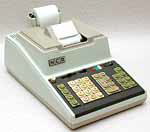
The Busicom 141-PF calculator and the Intel 4004 microprocessor
The fascinating story of why the development of a calculator led to the development of the first commercial microprocessor, and the unexpected consequences.
© 2009 Nigel Tout
This is a new article which was not originally in "The International Calculator Collector".
Busicom Corporation
One of the most technologically adventurous calculator manufacturers in the late 1960s and early 1970s was the small Japanese company Busicom Corporation. Under its previous name of Nippon Calculating Machine Corporation (NCM) it produced mechanical pinwheel calculators in the mid-1960s.
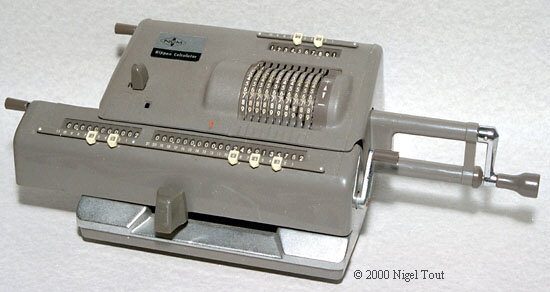
NCM/Busicom HL21 mechanical pinwheel calculator.
In the second half of the 1960s Busicom developed and marketed an advanced series of electronic desktop calculators. During this time calculator electronics was at the leading edge of semiconductor development and, like other companies, Busicom took advantage of these developments which increased the number of components that could be incorporated in an integrated circuit. This lead to the reduction in complexity, and hence size and cost of electronic calculators.
In the late 1960s Busicom sought contracts with U.S. semiconductor companies, which were then the leaders in semiconductor development, to produce advanced integrated circuits for its calculators and other business machines.
Two contracts in particular were of great technological importance. The first was with Mostek for the development of advanced LSI (Large-Scale Integration) technology for Busicom's basic calculators that were manufactured in its Osaka factory.
The second contract was with a small start-up company, founded in 1968, called Intel Corporation. The tale of this contract is told here:
Busicom meets Intel
Starting in 1968 a young engineer at Busicom, Masatoshi Shima, worked on the design of Busicom's first calculator with printed output, the Busicom 141-PF. Due to the pressure for rapid development, Shima's supervisor, Tadashi Tanba, using his experience while working at the advanced computer manufacturer Control Data Corporation, had started a design based on a programmed approach using computer software technology with desktop calculator hardware. This would allow easy changes to be applied to alter the specification of the calculator or control other products in their business product line.
Shima, who had some programming experience, took this "computer system" approach further and produced a design for the 141-PF incorporating arithmetic units (adders), multiplier units, registers, read-only memory, and he even defined the macro-instruction set to control this decimal computer system.
Tadashi Sasaki was an executive for Sharp Corporation, a major manufacturer of electronic calculators, and had had a good working relationship with Bob Noyce of Fairchild Semiconductor Corporation, the U.S. integrated circuit manufacturer. In 1968 Noyce left Fairchild to start up Intel Corporation with Gordon Moore, and shortly afterwards visited Sasaki at Sharp in Japan to try to sell Intel's integrated circuits. Unfortunately, Sharp was contracted to Rockwell for the exclusive supply of calculator integrated circuits so no business with Intel was possible.
However, Sasaki had graduated from the same university department as Yoshio Kojima, the president of the up and coming Busicom Corporation, and so felt empathy for Kojima and his company, which was struggling financially. This resulted in Sasaki, as an executive of the large Sharp Corporation, offering some technical assistance to the much smaller Busicom, a business situation that was allowed in Japan. However, working behind the scenes, Sasaki went a step further and offered finance to Busicom on the condition that it contracted Intel Corporation to develop the integrated circuits for Masatoshi Shima's "computer system" design for the 141-PF calculator.
Intel's proposal
In 1969 Masatoshi Shima was one of three Busicom employees who traveled from Japan to Intel in the U.S.A. with details of the proposal for the integrated circuits for the 141-PF and other advanced calculators, which would differ just by the contents of the instructions in the ROM (Read-Only Memory) chips.
Intel put Marcian E. "Ted" Hoff in charge of the project with the assistance of Stanley Mazor, another engineer.
There was little progress in the first year of the project. Intel knew little about calculator electronics and how to use the proposed line printer, and was not very enthusiastic about developing the proposed integrated circuits. Also it considered that for its small development staff there were too many chips required, the designs were too complicated and required non-standard packaging with large numbers of pins, and they had enough to do working on the RAM (Random-Access Memory) chips that were Intel's principal product and were starting to sell well.
Hoff had been working with a DEC PDP-8 computer and appreciated its RISC (Reduced Instruction Set Computer) architecture which simplified the electronics at the expense of a bigger memory for the larger program required. And, happily, Intel was a memory chip manufacturer.
Hoff proposed a much simplified system using a few standardised chips employing a limited instruction set so that different combinations of the simple instructions could be used for different actions such as reading the keyboard and driving the printer. Use of a small chipset to produce a computing system was actually something that had been foreseen by many in the computing and semiconductor industries for some time, but Intel had the manufacturing capability and here was a specific proposal.
Intel was in two minds. On the positive side there would be much less chip development required for Hoff's proposal than Busicom's proposal, but it still did not really have the development staff available, and would it make any money after the development costs for a small production run of specialised chips for one company?
For some months Shima and Hoff continued to work on their different designs at Intel. However, in October 1969, Busicom executives visited Intel and they were given presentations on the two proposals. The Busicom executives decided to go with Hoff's proposal, perhaps somewhat surprisingly since they would have been expected to favour their in-house proposal.
Since Hoff's design was to go ahead Shima dropped the work he had been doing and started to work on Hoff's design, and then went back to Japan at the end of 1969 to finish the programming and produce the documentation. When Shima returned to Intel in April 1970 to check on how the development was progressing he was aghast to find that nothing further had been done. Hoff had been moved from this job to the development of another central processing unit for an intelligent terminal for Computer Terminal Corporation. This cpu would become the very successful Intel 8008.
All was not lost, however, since Intel had in the meantime recruited Federico Faggin to complete the design of the circuits and he had arrived at Intel shortly before Shima's visit. Faggin, who already had a reputation as one of the best chip designers, worked, with help from Shima and Mazor, for the next year to perfect the chip-set and get it into production.
The chip-set comprised[1]:
- 4001, 2048-bit metal-mask-programmable read-only memory (ROM) with a 4-bit programmable I/O port. This ROM was only mask programmable during manufacture, and was organised as 256 x 8-bit words.
- 4002, 320-bit random-access memory (RAM) and 4-bit output port.
- 4003, 10-bit shift register
- 4004, 4-bit central processing unit (CPU) (the microprocessor) with a maximum clock speed of 750 kHz.
Complete 4004 chip-sets were sent to Busicom early in 1971 and by March Shima had built a working 141-PF calculator. In the following month Busicom started manufacturing the 141-PF calculator, together with other business equipment incorporating the chip-set.
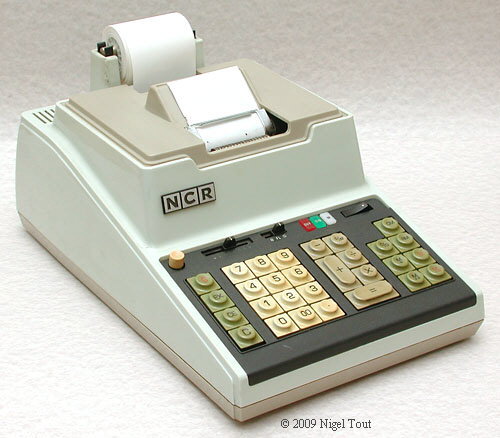
A Busicom 141-PF calculator, here badged as an NCR 18-36, as sold by the National Cash Register Company.
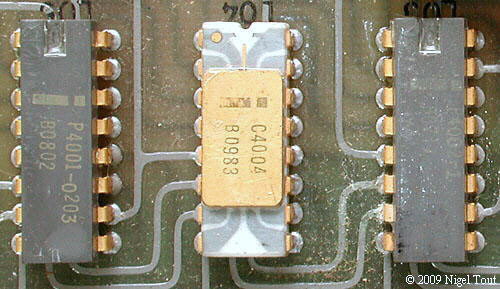
For the first time, the classic microprocessor system:
In the middle the microprocessor (4004), with on the left the ROM (4001), and on the right the RAM (4002).
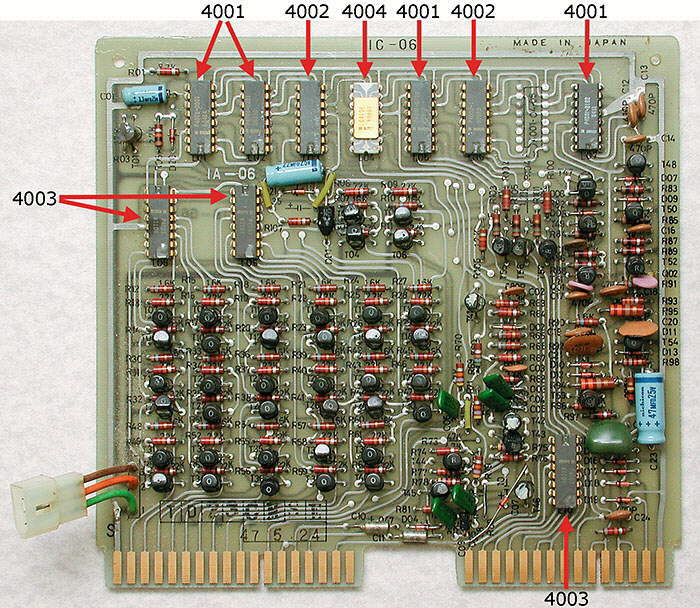
The single control circuit board of the Busicom 141-PF calculator, showing the Intel 4004 microprocessor and associated integrated circuits.
These are:
- 4 off 4001, read-only memory (ROM). The board also has one blank space which is marked for another 4001.
- 2 off 4002, random-access memory (RAM).
- 3 off 4003, shift register
- 1 off 4004, 4-bit microprocessor (the central processing unit, CPU).
The black devices with an 'O' or 'R' on top are single transistors.
Microprocessor Dawn
So the scene was set for Intel to continue manufacturing the 4000 series chip-set and for Busicom to sell them incorporated in its calculators and other business products.
Busicom, however, was still having financial problems exacerbated by the fall in prices of electronic calculators as more companies ramped up production and the cost of the electronic components fell.
So, almost immediately, Busicom started to renegotiate the cost of the chip-set to try to get it at a reduced price. Faggin recommended to Bob Noyce (the Intel president) that they should cut the cost to Busicom, but only if they could persuade Busicom to waive its condition on it being the only purchaser of the chip-set. Although there was not much enthusiasm in some quarters at Intel for such an agreement Busicom agreed to it, and Intel became free to sell the chip-set to anyone. It was given the name MCS-4 (Micro-Computer System 4-bit).
But who would be interested in using the Micro-Computer System?
At the time, on the one hand, computers were largely perceived as being huge mainframe machines that required air-conditioned rooms and an army of attendants. Whereas on the other hand, small electronically controlled machines used lots of small-scale logic circuits or expensive, bespoke, integrated circuits. The Microcomputer System did not immediately appear suitable for either of these applications.
The Intel management were still not very enthusiastic either, and there was a feeling that they did not want to enter the computer systems business with the MCS-4. However, Faggin made a production tester for the 4004 which actually used the 4000 chipset, so demonstrating that it had other general uses as well as in calculators.
Fortunately for the MCS-4, Intel had just hired a new marketing director, Ed Gelbach, who had previously been at Texas Instruments (TI) where there was much greater interest in general logic circuits, and he was all in favour of the MCS-4.
Around this time, April 1971, there was a very prophetic small article in the magazine 'Electronics'[2]: "While the Intel set—a controller, an interface,
a read-only memory, and a random access memory—was custom designed, Busicom says that Intel can sell it to other companies if Busicom approves.
That proviso just about rules out other calculator
makers. But Robert F. Graham, vice president of marketing at Intel, says he envisions a market for the chips anyway—the industrial process control field. Graham says that the same versatility that Busicom wanted
in the calculator set—the same basic chips can be used in a complete line of calculators—also will provide designers of digital control equipment both flexibility and the cost break in buying a standard
set.
The set combines to produce a machine that is just like a computer. "We have a CPU, an I/O buffer, and a mainframe memory that's split up into two sections—the ROM for addresses and the RAM
for data", says Graham. The basic set is a calculator, so it is good at arithmetic and arithmetic operations similar to those employed in controllers for, say, canneries or fuel oil processing plants. One CPU chip can
be combined with up to 16 RAMs and up to 32 ROMs. All are interconnected on a four-line data bus."
However, a trade advertisement revealed to a shocked Intel that Texas Instruments had full MOS (Metal-Oxide Semiconductor) LSI (Large-Scale Integration) manufacturing capability and was working on the development of a CPU (Central Processor Unit = microprocessor). This was for Computer Terminal Corporation (CTC), with which Intel also had a contract. As it turned out Intel proposed its own microprocessor design, the 1201 (which was later renamed the 8008), to which project Ted Hoff had been moved from the 4004. TI in fact experienced considerable problems trying to develop their design for CTC.
The response to Intel's first advertisement for the MCS-4 in 1971 and at the first trade fair at which it was shown was overwhelming, in fact better than for any other component that it had launched.
Significantly, initial sales of the MCS-4 chip-set were small (often in quantities of one or two as samples were bought to try out), and Intel made more money by selling the design tools, such as prototyping boards and software assembler and simulators to development engineers. This demonstrated that there was great interest in exploring the capabilities of the microprocessor and that selling microprocessors required a different approach to selling other components.
The Conclusion
The microprocessor was about to become a standard component and was to be designed into all sorts of products, greatly accelerating the digital revolution. Intel's 8008 was soon launched, and further improved microprocessors steadily followed, the 8080, 8086. Other semiconductor companies brought out there own microprocessor designs, including Texas Instruments. By the mid-1970s the first personal computers were coming on the market, and in 1981 IBM launched its PC, from which so many other personal computers were developed. Intel development continued to produce the 80286 microprocessor, the 80386, and on to the well known Pentium and its stablemates.
Federico Faggin left Intel in 1974 to start up Zilog where he designed the Z80 microprocessor, an improvement on the Intel 8080, and one of the world's highest selling microprocessors.
Intel had never patented the 4004 microprocessor, since they had considered it as just another application of LSI (Large-Scale Integration) semiconductors. Texas Instruments applied for a U.S. patent on the microprocessor in 1971 and it was awarded to one of its employees, Gary Boone in 1973 (U.S. patent 3,757,306).
Interestingly, in 1990 it was reported that Gilbert P. Hyatt, an inventor in Southern California, was granted a patent for a design for building a computer on a single chip. Hyatt had filed for the patent in 1970 based on work he started in 1968. It is further reported that this patent was invalidated after Texas Instruments pleaded that no such device was manufactured at the time and that it was incapable of being manufactured with the technology then available.
And as for Busicom:
The use of microprocessors in simple calculators was not economic, though Texas Instruments TMS1000 series microprocessors would be used in some more sophisticated models.
While the 141-PF calculator was being developed the "calculator on a chip" had been brought to market by Mostek, actually resulting from the contract from Busicom mentioned near the top of this article. Busicom used the Mostek MK6010 "calculator on a chip" to launch the first pocket calculator, the Busicom LE-120A "Handy" in early 1971. The later Busicom 121-PK calculator was operationally identical to the 141-PF but was much cheaper and employed the Mostek MK6018 and MK6019 calculator integrated circuits.
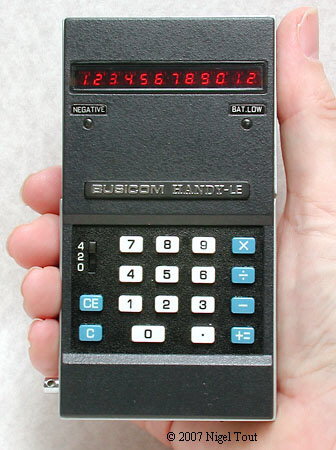
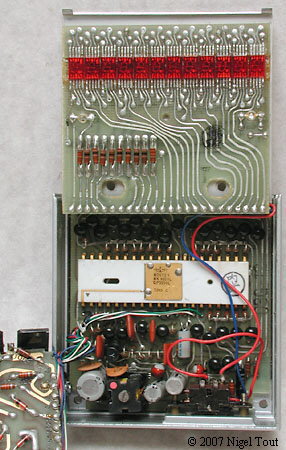
While the 4000 series microprocessor chip-set was being developed, the "calculator on a chip" MK6010 was developed for Busicom by Mostek. The use of just one chip and a few additional components allowed the production of the first pocket-sized calculator, the Busicom LE-120A "Handy" shown here.
With the dramatic reduction in the cost of calculators Busicom's continuing financial difficulties finally got the better of it and it ceased production in 1974. However, the Busicom name was bought by a distributor and continues on calculators to this day, though manufactured by a variety of companies.
Early calculators which used microprocessors:
- Busicom 141-PF calculator (described above), also badged as NCR 18-36, Unicom 141P.
- Rockwell 920 desktop calculator which uses the early Rockwell PPS-4 microprocessor system.
- Goudime Astronavigation Calculator. A Prototype Navigation Calculator from 1975 based on the the Intel 8080 Microprocessor.
At the following link there is a German translation of this article.
General references:
- Aspray, William, "The Intel 4004 Microprocessor: What Constituted Invention?", IEEE Annals of the History of Computing, Vol. 19, No. 3, 1997.
- Malone, Michael S., (1995) "The Microprocessor: A Biography", Santa Clara, Telios.
- 'Intel 4004 - 50th Aniversary Project'
Specific references:
- Intel MCS-4 Microcomputer Set, instruction sheet, November 1971: http://datasheets.chipdb.org/Intel/MCS-4/datashts/MCS4_Data_Sheet_Nov71.pdf.
- "Intel set to chip at process-control field", Electronics, April 26, 1971, p25.
Calculator Articles
Vintage Calculators
Text & photographs copyright, except where stated otherwise, © Nigel Tout 2000-2026.